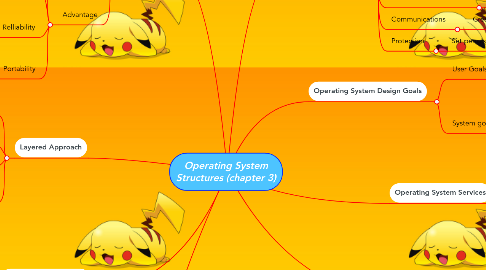
1. Additional Operating System Fuctions
1.1. Resource Allocation
1.2. Accounting
1.3. Protection And Security
2. Communication Models
2.1. Message Passing
2.1.1. In message passing model, communication takes place by means of messagers exchanged between the process
2.2. Shared Memory
2.2.1. In shared memory model, a region of memory that is shared by processes can exchange information by reading and writing data to the shared region
3. Layered Approach
3.1. Operating system is divided into a number of layers(levels), each built on top of lower layers.
3.2. Bottom layer(layer 0) is the hardware; the highest(layer N) is the user interface.
3.3. Advantage
3.3.1. Simplicity of construction and debugging
3.4. Disadvantages
3.4.1. The careful definition and interaction of the layers
3.4.2. Less efficient
4. Microkernel
4.1. The main function of microkernel is to provide communication facility.
4.2. Both user program and services are running on user mode.
4.3. However, user program and services never interact directly.
4.4. They communicate directly by exchanging message with microkernel.
4.5. Advantage
4.5.1. Extensibility
4.5.1.1. Allows the addition of new services
4.5.2. Flexibility
4.5.2.1. New features added
4.5.2.2. Existing features can be subtracted
4.5.3. Relliability
4.5.3.1. Modular design
4.5.3.2. Small microkernel can be rigorously tested
4.5.4. Portability
4.5.4.1. Changes needed to port the system to a new processor is changed in the microkernel-not in the other services
5. Operating System Services
5.1. User Interface
5.2. Program Execution
5.3. I/O Operations
5.4. File-system manipulation
5.5. Communication
5.6. Error Detection
6. System Calls.
6.1. Three general methods are used to pass parameters between a running program and the operating system.
6.1.1. Pass the parameters in registers.
6.1.2. Parameters stored in a block or table in memory and address of block passed as a parameter in a register.
6.1.3. Parameters placed or pushed onto the stack by the program and popped off the stack by the operating system.
7. Types Of System Calls
7.1. Process Control
7.1.1. Create process
7.1.2. Terminate procss
7.2. File Management
7.2.1. Create file
7.2.2. Delete file
7.3. Device Management
7.3.1. Request device
7.3.2. Release device
7.4. Information Maintenanc
7.4.1. Set time and date
7.5. Communications
7.5.1. Create/delete communication connection
7.6. Protection
7.6.1. Set permission
8. Operating System Design Goals
8.1. User Goals
8.1.1. Convenient to use
8.1.2. Easy to learn
8.1.3. Safe and fast
8.2. System goals
8.2.1. should be easy to design
8.2.2. error-free

